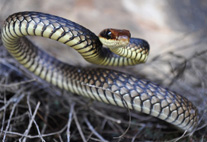Abstract
We describe a new species of Chironius Fitzinger, 1826 from the highlands of Chapada Diamantina, state of Bahia, Brazil. The new species is distinguished from all currently recognized congeners by a unique combination of states of characters on coloration, scale counts, scale ornamentation, and hemipenis. The new species closely resembles Chironius flavolineatus (Jan, 1863) in color pattern, but differs from the later taxon by the presence of two to four posterior temporal scales; cloacal shield entire; six to ten rows of keeled dorsal scales at midbody; ventral scales with posterior dark edges forming conspicuous transverse bars along almost the entire venter; conspicuous dark longitudinal stripes (in “zigzag”) in the midventral portion of subcaudals; region of medial constriction of hemipenis slightly covered with spinules separating calyces of apex from spines below region of constriction; and sulcus spermaticus situated on convex face of hemipenis in lateral view. The new species is apparently restricted to Chapada Diamantina, corroborating the biological importance of this region from a conservational perspective.

